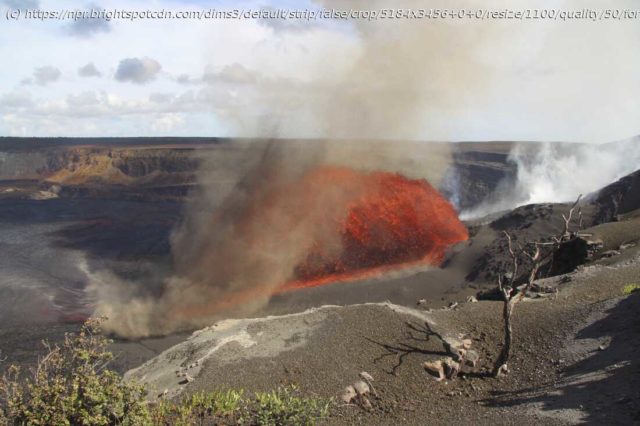Hawaii’s Kilauea volcano resumed erupting Friday by shooting an arc of lava 100 feet into the air and across a section of its summit crater floor.
Hawaii’s Kilauea volcano resumed erupting Friday by shooting an arc of lava 100 feet (30 meters) into the air and across a section of its summit crater floor.
It was Kilauea’s 31st display of molten rock since December, an appropriately high frequency for one of the world’s most active volcanoes.
The north vent at the summit crater began continuously spattering in the morning, and then lava overflowed a few hours later. The vent started shooting lava fountains in the afternoon.
The eruption was contained within the summit crater, and no homes were threatened.
A few lucky residents and visitors will have a front-row view at Hawaii Volcanoes National Park. If the past is a guide, hundreds of thousands more will be watching popular livestreams made possible by three camera angles set up by the U.S. Geological Survey.
Whenever she gets word the lava is back, Park Service volunteer Janice Wei hustles to shoot photos and videos of Halemaumau Crater — which Native Hawaiian tradition says is the home to the volcano goddess Pele. She said that when the molten rock shoots high like a fountain, it sounds like a roaring jet engine or crashing ocean waves. She can feel its heat from over a mile away.
«Every eruption feels like I am sitting in the front row at nature’s most extraordinary show», Wei said in an email.
Kilauea is on Hawaii Island, the largest of the Hawaiian archipelago. It’s about 200 miles (320 kilometers) south of the state’s largest city, Honolulu, which is on Oahu.
Here’s what to know about Kilauea’s latest eruption:
A lower magma chamber under Halemaumau Crater is receiving magma directly from the earth’s interior at about 5 cubic yards (3.8 cubic meters) per second, said Ken Hon, scientist-in-charge at the Hawaiian Volcano Observatory. This blows the chamber up like a balloon and forces magma into an upper chamber.
Домой
United States
USA — Science Hawaii's Kilauea volcano erupts again and shoots lava for 31st time since...






